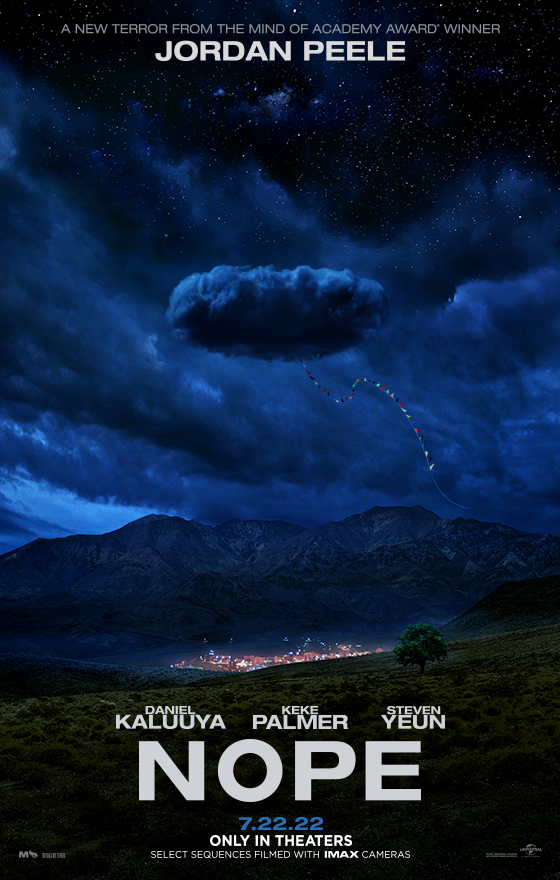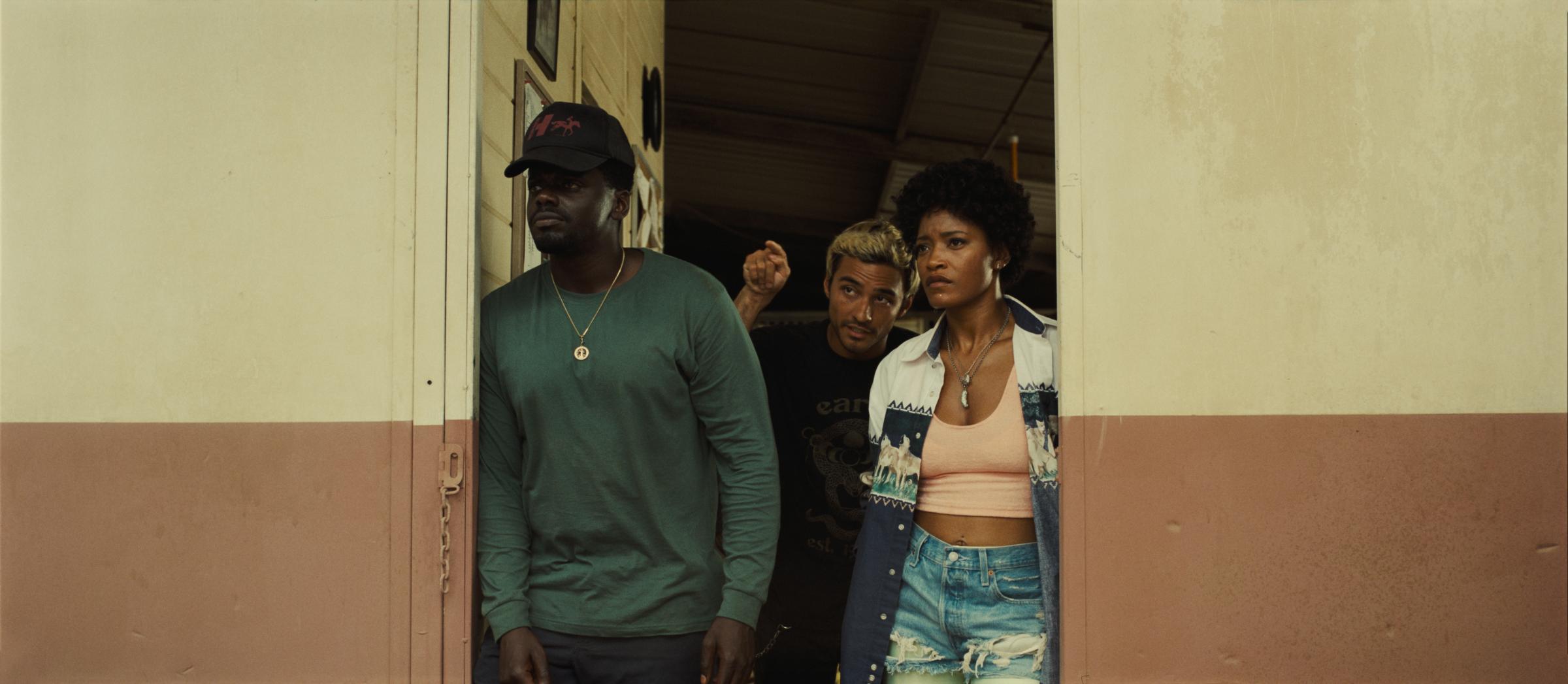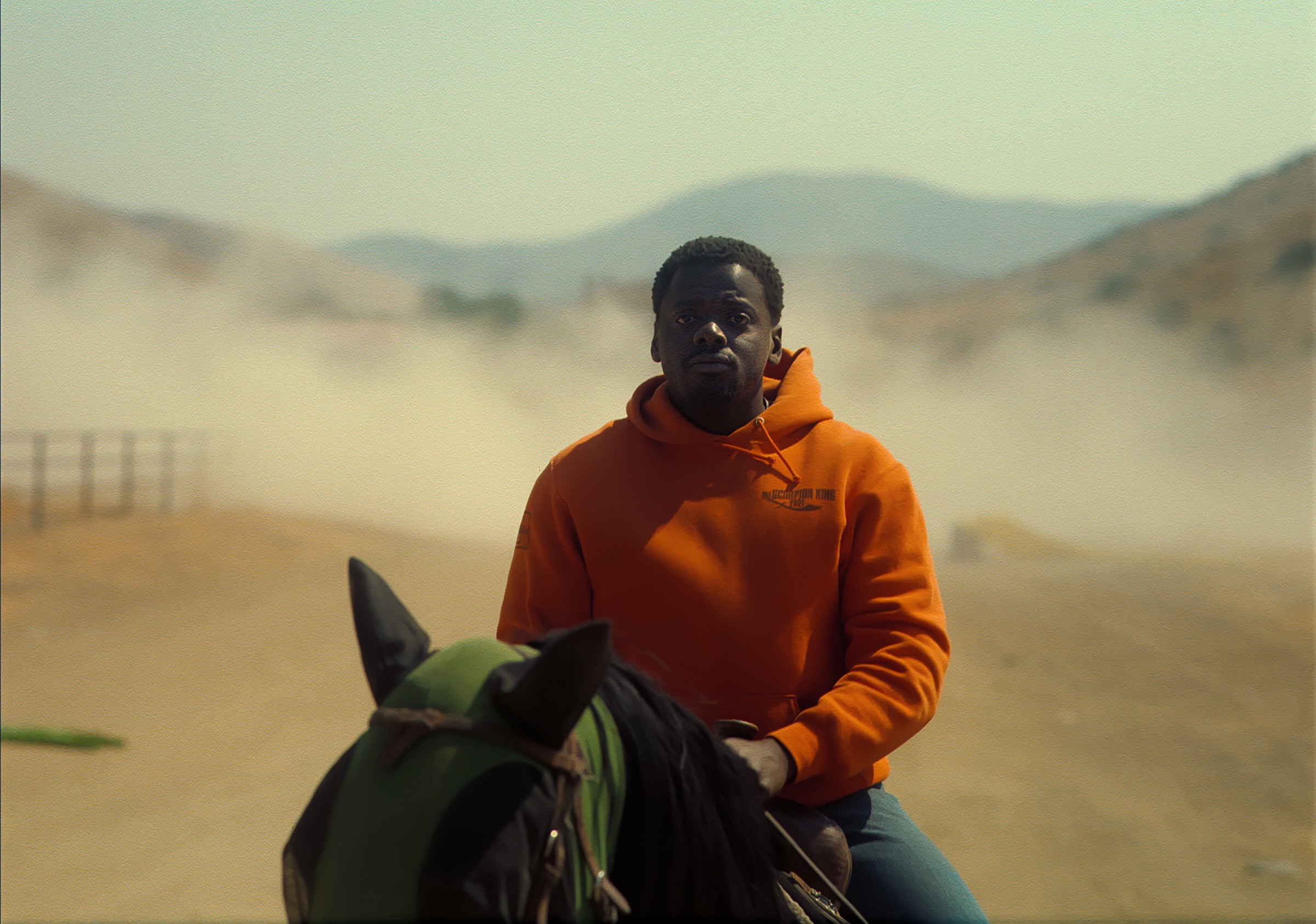Leading up to its release on July 22, Jordan Peele kept his highly-anticipated third film, Nope, tightly under wraps. The trailer is little more than a spooky montage of dark forces and craning necks, and Peele was very cagey about what happens in the movie in the few interviews he’s given. His elusiveness sparked a whole host of wild fan theories and predictions: that the movie is about government drones, or time travelers, or the MMA fighter Angela Hill.
Well, two TIME reporters saw the film—and walked out of it with even more theories and questions than when we walked in. Nope, which is available to stream on Peacock as of Nov. 18 as well as to rent on other digital platforms, is a transfixing and hugely ambitious movie with a perplexing array of disparate characters and symbols: a murderous chimp, inflatable dancing men, a flying saucer. By the time the film has ended, the A-plot has resolved itself neatly. But in the two packed theaters where we screened the film, theatergoers remained silent and still as the credits rolled, suggesting some sort of confusion, or at least unease, with the whole thing.
As TIME’s film critic Stephanie Zacharek put it, “Peele, it seems, is one of those ‘It means what you think it means’ filmmakers, which delights some audiences but comes off as a copout for viewers who want to know what a filmmaker is thinking, because ostensibly those thoughts are more interesting than anything we could come up with on our own.”
So, just like the movie’s characters, we’ll try to interpret what we’ve seen before us while mixing in grandiose conspiracy theories to answer one big question: What, exactly, is Nope about? Spoilers, of course, abound.
Nope is simply a summer monster movie

Jordan Peele’s movies beg to be closely scrutinized: they’re full of historical and cultural Easter eggs, double meanings and sociopolitical commentary. His first two films, Get Out and Us, have provoked endless analysis from professors, psychologists, and historians, with Get Out even inspiring a whole class at UCLA. Peele isn’t shy about his conceptual ambition and his penchant for writing Big Themes into genre storytelling: “Humanity is the monster in my films,” he told Vanity Fair in 2017.
But in the last few months, Peele has signaled that Nope is different in that regard, that his intentions may be more visceral and surface-level. “I wrote it in a time when we were a little bit worried about the future of cinema,” Peele said. “So the first thing I knew is I wanted to create a spectacle… the great American UFO story.”
And after watching Nope, it’s easy to read it purely as a summer popcorn movie; a break from what critics might perceive as heavy-handed didacticism. The main plot of the film is simple, slotting neatly into a thriller/horror lineage of a group of good guys trying to kill a scary monster. (See: Jaws, Alien, The Thing.)
Late in the movie, Daniel Kaluuya’s OJ lays out the monster’s motivations very clearly: “It’s alive, it’s territorial, and it wants to eat us.” This mute, faceless monster doesn’t seem to be a stand-in for, say, Manifest Destiny or global warming: it’s simply a vehicle for making audiences shriek, riffing on a rich cinematic history of UFOs, and capturing gorgeous shots of the expansive SoCal desert sky.
Peele spares no expense in that last regard: he hired cinematographer Hoyte Van Hoytema, who shot Christopher Nolan epics like Dunkirk and Interstellar, to film this one using IMAX cameras. The director has made it very easy for audiences to get wrapped up in the film’s visual beauty and heart-racing motorcycle-driven set pieces; to mostly turn off their Hot Take brains and enjoy a furious battle for survival.
Nope—it’s actually a parable about the power of cinema

But for characters battling a giant sky monster that eats people, they spend an awful lot of time primarily worried about… filming it?
It seems like a quarter of all movies that make it into theaters these days are so-called “love letters to Hollywood” (see: La La Land, Mank, Once Upon a Time…In Hollywood, Licorice Pizza). Nope repeatedly gestures toward that subgenre. The movie is very clearly attempting to place itself within several cinematic lineages: Western, horror, sci-fi, buddy-comedy. The very first shot takes place on a Hollywood television set (albeit during the rampage of a murderous chimp). Easter egg references to film history abound, whether in the form of OJ’s Scorpion King hoodie or his Buck and the Preacher poster.
But the characters aren’t just fans of movies: they’re obsessed with the act of filming and documenting life. For OJ, Emerald (Keke Palmer), and Angel (Brandon Perea), the UFO only truly exists if they’ve captured it on film. They spend the first half of the movie interacting with it mostly through screens, as if poring over their own Zapruder tape. They set up a wildly ambitious obstacle course—complete with those wacky inflatable men—not to physically capture the beast but to use the footage as their golden ticket to becoming Hollywood royalty.
The movie’s climax goes even further in centering the act of filmmaking. As the monster floats off into the sky, Emerald unleashes a giant inflatable balloon cowboy—a definitive symbol of Classic Hollywood if there ever was one—as an airbound weapon, then furiously snaps her camera as she repeatedly attempts to get one perfect shot.
It’s a curious and self-serving twist on the “final shoot-out” trope, with a film roll replacing bullets. In the battle between good and evil, the film seems to be saying, it’s the actual art of filmmaking, combined with the ingenuity of filmmakers harnessing the power of Hollywood heroes, that might be humanity’s last hope.
However, there’s another way of interpreting the movie not as a love letter, but as an outright condemnation of Hollywood instead. More on that later.
Nope—it’s a critique of surveillance culture

We’re still not entirely sure what the gaping organ on the underbelly of our UFO-turned-predator is (a mouth? An eye? Both?), but it certainly does seem to be watching us. OJ pieces this together, too, when he interrupts a burger run to posit that maybe the creature—like a horse—spooks at direct eye contact. It wants to watch, never to be watched. And Jupe (Steven Yeun) gets close to the point when he announces to the crowd at his amusement park that “We are being surveilled by an alien species I call the Viewers.” (Maybe the one thing Jupe was right about, poor guy.)
“Surveillance” is a weighty term here, given its history and significance in relation to policing the Black community. If the alien is, in fact, always watching them from inside that cloud, then the Haywoods’ ranch starts to feel a bit like a panopticon—a central observation tower within a ring of prison cells. To the prisoners, it feels like someone is constantly watching them, and all sense of privacy is lost. In her book Dark Matters: On the Surveillance of Blackness, Simone Browne draws a comparison between the panopticon and slave ships: Both institutions police and dehumanize people, creating a system of power and control.
But when OJ whips out his cell phone—a tool often used to document police brutality—to record the kids pranking him in the barn, he’s turning the tables on the threat at hand. And when Angel helps the Haywoods install security cameras on their property, the watched become the watchers, reasserting their power. By capturing evidence of the creature, they’re ensuring that they will be believed—and that they can control the narrative. So when Emerald snaps that last, sweat-stained photo on the Winkin’ Well, maybe that’s a win, pushing back against surveillance culture.
Nope—it’s about Black historical documentation

Or maybe that Winkin’ Well photo has a different meaning entirely.
Toward the beginning of the movie, Emerald explains to a sound stage full of people that her great-great (great) grandfather was the jockey who was the subject of the first known assembly of photographs creating a motion picture. Those photos were assembled by Eadweard Muybridge, known by many as the “forefather of cinema.” The name of the jockey, however, remains unknown. “We’ve got the first movie star of all time,” Peele told GQ. “And it’s a Black man we don’t know. We haven’t looked. In a lot of ways, the movie became a response to that first film.”
When OJ and Emerald embark on a quest to record the alien, then, maybe they’re seeking to document history, leaving their own indelible mark in the textbooks.
“Ain’t nobody gonna get what we gonna get,” Emerald tells her brother inside Fry’s Electronics. “What we gonna get?” OJ asks. “The money shot,” Emerald replies. “Undeniable proof of aliens on camera. The Oprah shot.” Securing the Oprah shot would cement the Haywoods’ place in history—which should have already been established, given the family lineage. The act of “archiving while Black,” as the academic Ashley Farmer has put it, can be inherently radical, as Black scholars, historians and activists historically have been shut out of the preservation of their own history.
The Haywood siblings make a false step in Nope, when they entrust the documentation of the creature to the eccentric filmmaker Antlers Holst (Michael Wincott), who Emerald claims is the only person in the world who can get it on film, and who happens to be white.
As OJ ducks for cover inside a structure with walls made out of wooden slats, a horse gallops by in the background, evoking the praxinoscope feel of the Muybridge clip. Then we’re treated to the remake itself, the pièce de résistance: a gorgeous sequence of OJ galloping through the arid, stark landscape of Southern California, recreating and reclaiming his great-great-great-grandfather’s legacy.
“It’s about taking up that space,” Peele told GQ. “It’s about existing. It’s about acknowledging the people who were erased in the journey to get here.”
Then Antlers is gone, leaving Emerald as the last woman standing to capture this slice of history for both her family and the world at large. And with every last ounce of energy—and frankly impressive upper body strength—she succeeds, snapping the Oprah shot on the trusty ol’ Winkin’ Well.
Nope—Nope is about capitalism

You knew we’d end up here, didn’t you?
By now, it’s a cliche to yell “late stage capitalism!” about pieces of media that even reference economic structures or wage labor. But bear with us here: When you zoom out, it becomes evident that the throughline of each of Nope’s subplots is the grave danger of wrangling the untameable into a for-profit spectacle.
First, it’s the Haywood family, whose entire legacy rests upon converting majestic stallions into show ponies to be ridden by washed-up actresses in commercials. Next, it’s the creators of Gordy’s Home, who chased viewership ratings so blindly, they ignored the Chekhov’s Ape about to detonate on his poor castmates.
The Gordy massacre clearly had a traumatic effect on poor Jupe, who witnessed his castmates getting mauled firsthand. But society taught him that the tragedy was something to be mined for commerce and comedy: We’re sure Chris Kattan killed in the SNL sketch that Jupe describes. And as a child actor, Jupe never knew anything else. It’s his Stockholm Syndrome, chained as he is to Hollywood ideals, that makes him attempt to turn the UFO into his new Gordy—because even in the worst case bloody scenario, maybe a good SNL skit and a few thousand bucks will come out of it.
Jupe’s attitude of embracing risk for the sake of success isn’t the exception, but the status quo. For the Haywood siblings, filming the UFO is the key to their family’s very survival. (It’s not like OJ could take bereavement leave after his father’s death.) In their near-suicidal quest to monetize the monster, they’re not all that different from the TMZ cameraman who begs for OJ to save his footage as he lays dying in the dirt.
This theme directly taps into that of two of Hollywood’s classic monster movies, King Kong and Jurassic Park: that the masses’ desire for believably terrifying and titillating spectacles can only end in disaster. And as long as tickets are sold, there are those like Jupe or the cinematographer Antlers who will happily create deathly shows. The line between obsessive craftsmanship and obsessive commerce-creation becomes nearly indistinguishable, as they each lead to the same violent ends.
Watching Antlers die, it’s hard not to think of Halyna Hutchins, the real-life cinematographer who was shot to death by accident last year on a New Mexico film shoot of an Alec Baldwin Western. On that shoot, crew workers had complained of safety lapses and unsafe working conditions due to a tight budget and strict productivity mandates. The incident brought to light a long history of fatal accidents on film sets, often stemming from producers cutting corners to save money. With this history in mind, the characters’ attitudes of film-above-life leaves a very sour taste, and calls into question every one of their actions.
Peele himself leaves a very strong hint toward this interpretation’s veracity in the film’s first frame, which shows a grim Bible quote from the prophet Nahum: “I will cast abominable filth at you, make you vile, make you a spectacle.” Nahum says this to justify the destruction of the city of Nineveh, which he argues is overrun by sin and vice, and must be cleansed. Peele’s UFO monster, then, can be read as making a moral judgment from on high of humanity’s obsession with money and spectacle—and raining down upon them filth and blood as punishment.
Nope. We’re overthinking it

But the question remains: Do we have to have our cake and eat it too? Do we need both a big, fun summer monster movie and a treatise on the follies of capitalism in Hollywood? Or can we just let Jordan Peele enjoy his cake: a well-deserved dessert after the daring, draining concepts of Get Out and Us?
Both of Nope’s forerunners delved deep into dark places. The Sunken Place and the Tethered—though central to two timeless cinematic masterpieces—demanded a lot of both Peele and his viewers. The Haywood ranch, on the other hand, infuses this film with sheer thrills, edge-of-your-seat terror and the joy that can accompany it. “There’s also a way to watch this movie where you say, ‘Look, I’ve been working all day, all week,’” Peele told Uproxx. “’I want to shut off and see some wild stuff.’”
Peele, as he’s proven time and time again, is a master of cinematography and filmmaking. Maybe we should step back from all of the overanalysis (as fun as it may be) and just let him do what he does best: make one hell of a movie.
More Must-Reads from TIME
- Cybersecurity Experts Are Sounding the Alarm on DOGE
- Meet the 2025 Women of the Year
- The Harsh Truth About Disability Inclusion
- Why Do More Young Adults Have Cancer?
- Colman Domingo Leads With Radical Love
- How to Get Better at Doing Things Alone
- Michelle Zauner Stares Down the Darkness
Contact us at letters@time.com